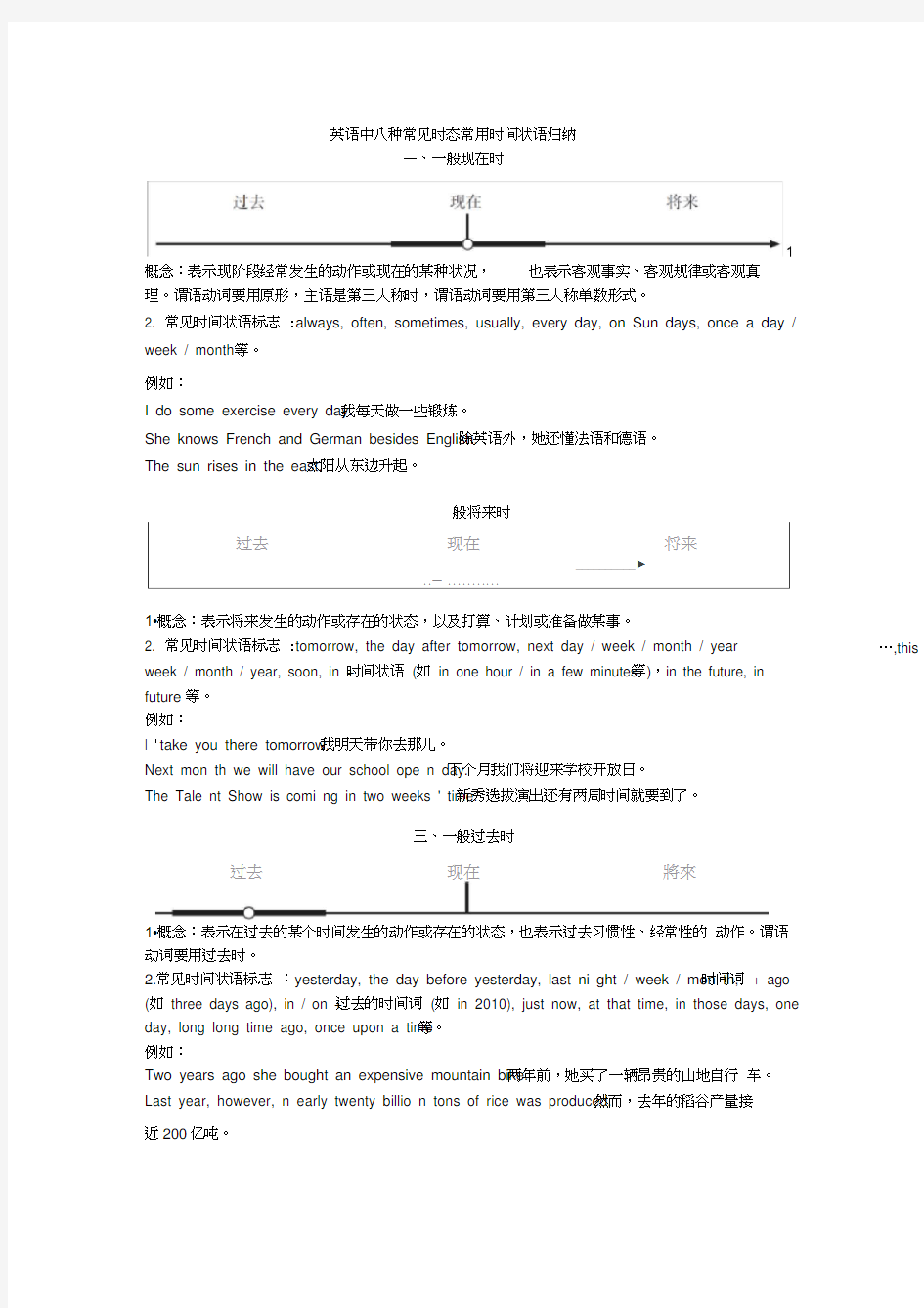英语中八种常见时态常用时间状语归纳


概念:表示现阶段经常发生的动作或现在的某种状况, 也表示客观事实、客观规律或客观真 理。谓语动词要用原形,主语是第三人称时,谓语动词要用第三人称单数形式。
2. 常见时间状语标志 :always, often, sometimes, usually, every day, on Sun days, once a day / week / month 等。
例如:
I do some exercise every day. 我每天做一些锻炼。
She knows French and German besides English.除英语外,她还懂法语和德语。
The sun rises in the east.太阳从东边升起。 般将来时
过去 现在 将来
__________ ?
..一 ...........
1?概念:表示将来发生的动作或存在的状态,以及打算、计划或准备做某事。
2. 常见时间状语标志 :tomorrow, the day after tomorrow, next day / week / month / year
week / month / year, soon, in + 时间状语 (如 in one hour / in a few minutes 等),in the future, in future 等。
例如:
I 'take you there tomorrow.我明天带你去那儿。
Next mon th we will have our school ope n day.下个月我们将迎来学校开放日。
The Tale nt Show is comi ng in two weeks ' time.新秀选拔演出还有两周时间就要到了。
1?概念:表示在过去的某个时间发生的动作或存在的状态,也表示过去习惯性、经常性的 动作。谓语动词要用过去时。
2.常见时间状语标志 :yesterday, the day before yesterday, last ni ght / week / mon th,时间词 + ago (如 three days ago), in / on + 过去的时间词 (如 in 2010), just now, at that time, in those days, one day, long long time ago, once upon a time 等。
例如:
Two years ago she bought an expensive mountain bike. 两年前,她买了一辆昂贵的山地自行 车。 Last year, however, n early twenty billio n tons of rice was produced. 然而,去年的稻谷产量接 近200亿吨。 英语中八种常见时态常用时间状语归纳 —、一般现在时 …
,this 三、一般过去时
过去 现在 將來
2.常见时间状语标志:now, at this time, at this moment, at present 等。
例如:
Now she is pla nning our schedule for the trip. 现在她正在为旅行制定时间表。
Today the nu mber of people lear ning En glish in Chi na is in creas ing rapidly. 当今在中国学习英
语的人数正在迅速增长。
注意:不用进行时的动词:
①表示感官的动词:如see (看见),hear (听见),feel (感觉出),taste (尝出),smell (闻到),notice (注意到),observe (观察到)等。
②表示某种情感或精神状态的动词:如believe, doubt, feel (= have an opinion), hate, image, know, (dis)like, love, prefer, realize, appreciate, recognize, remember, see (= understand), suppose, think (= have an opinion), understand, want, wish 等。
③一些用于交际和应答的动词:女口agree, appear, astonish, deny, disagree, impress, look (= seem), mean, please, promise, satisfy, seem, surprise等。
④表示所属、类似、构成等关系的动词和系动词,如:be, belong, concern, consist, contain, depend, deserve, fit, include, involve, lack, matter, measure (= have length etc.), need, owe, own, possess, weigh (= have weight)。
五、过去进行时
过去现在将來
1. 概念:表示过去某时刻正在进行的动作,或过去某一阶段一直在进行的动作,过去进行时由"was / were +现在分词”构成。
2. 常见时间状语标志 :(just) the n, at that time, yesterday after noon, the whole morning, all day yesterday, from 9 to 10 last evening / night, those days 等。
例如:
May I ask what you were doing in my restaura nt yesterday? 请问你昨天至U我的餐馆里来干什
么?
It was a cold day and his jacket was lying on the back of a chair. 天很冷,他的夹克衫搭在椅背
上。
3. 过去进行时和一般过去时的区别:过去进行时表示过去某时正在进行的动作,强调动作
的连续性;而一般过去时则表示一个完成的动作。
六、现在完成时
过去
⑴
(2)
1?概念:
1)表示动作发生在过去,但其结果影响到现在。
常见时间状语标志 :already, yet, just, ever, recently, so far, up to / till now 等。
2)表示动作或状态从过去某一时刻开始,一直持续到现在,还可能持续下去。
常见时间状语标志:for +时间段,since +时间点/过去时从句,ever since等。
3)表示说话前发生过一次或多次的动作,现在成为一种经历。
常见时间状语标志 :twice, ever, never, three times, before 等。
2. 基本结构:have / has +动词的过去分词。
3. 注意:非延续性动词不能用现在完成时+表示一段时间的状语”的句型中。这些动词有: come, go, start, leave, die, buy, fini sh, jo in, borrow, stop 等。但它们能够用表示持续状态的相应的延续性动词替换句中的非延续性性动词。如:
arrive, come 宀be here, be in
buy T have
begi n, start T be on
die T be dead
go out T be out
join T be in borrow T keep fini sh, end T be over
close T be closed leave, move T be away
fall asleep T be asleep
4. 现在完成时与一般过去时的区别:
现在完成时和一般过去时都表示过去发生的动作。差别在于:现在完成时强调的是动作
与现在的关系,即对现在的影响或动作延续到现在;而一般过去时只表示动作在过去某时发生,不表示和现在有关系。因此,句中有过去时间状语时,一般用一般过去时。试比较:
I have lost my new bike.我把新自行车丢了。(现在还未找到)
I lost my new bike yesterday.我昨天把新自行车丢了。(现在找到与否不清楚)
He worked there for three years.他在那里工作了3年。(现在已不在那里工作)
He has worked there for three years.他在那里工作已3年了。(现在仍在那里工作)
5. 注意:have / has gone to, have/has been to 禾口have / has been in 的区别:have / has gone to 表示人在去某地的路上或在某地,还未回来;
have / has been to表示人曾经去某地,并且人已经回来了;
have / has been in表示人已经在某地,常与一段时间连用。
七、过去完成时
1?概念:表示以过去某个时间为标准,在此以前发生的动作或行为,或在过去某动作之前的行为,即过去的过去”。
2.常见时间状语标志:before, by the end of last term / week / month / year 等。
例如:
Most of the guests had left whe n he arrived at the party.当他到达晚会现场时,大多数客人已经离开了。
By the 1990s the number had fallen to about 50,000.截止到20 世纪90 年代,(藏羚羊的)数量下降到了大约5万只。
Before he volun teered to direct the traffic, Timoteo had had lots of jobs. 铁穆特欧在志愿指挥交
通之前做过很多工作。
1. 概念:表
示从过去某个时间看即将发生的动作或存在的状态。过去将来时由“should / would +动词原形”构成。
2. 常见时间状语标志:通常在宾语从句中出现,主句谓语动词为过去时态。
例如:
She said she would be there at seve n o'clock, and he thought she would keep her word. 她说她会在7点到达,他认为她会守信用的。
They always told us that one day we would move into a house, a real house that would be ours. 他们那时总是跟我们说总有一天我们会搬进一所房子,一所真正属于我们的房子。
过去前做了
------------ .
规在前做了将来前做了
had been doing 过去某时前一亘在做have been doing
规在前一直在放
will h即e been doint 将来某时
前一直在做的
完咸进行时
